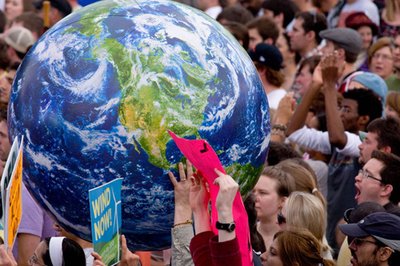Published April 18, 2013
On April 22 of each year people around the world plant trees, commute to work by bicycle and pick up trash in their neighborhoods to observe Earth Day, an event created to shine a spotlight on environmental concerns.
This image, known as the "Earth Flag", was created as a symbol of Earth Day by John McConnell, who helped pioneer the movement.
The first Earth Day was organized by Gaylord Nelson, a former U.S. senator from Wisconsin, in 1970 as a way to bring environmental protection onto the national political agenda.
"It took off like gangbusters. Telegrams, letters, and telephone inquiries poured in from all across the country," Nelson recounted in an essay shortly before he died in 2005. The first Earth Day was a teach-in modeled after the anti-Vietnam War protests. An estimated 20 million people participated.
Organizers expect more than a billion people in 192 countries to take part in the 2013 celebrations.
Earth Day helped build political support for environmental issues
Anger about the environment had been growing since scientist and writer Rachel Carson published ‘Silent Spring’ in 1962. The best-selling book documented the increased use of pesticides and chemicals after World War II, and the effects of pollution on animals and human health.
While the first Earth Day was open to anyone who wished to participate, some of the most enthusiastic Earth Day observers were in schools and universities around the country.
"We had reports on over 10,000 high schools doing something," said Senator Nelson, "and I personally heard from more than 2,500 colleges and from some 2,000 communities. It was a great educational effort, and it should be continued."
That show of public support is credited with helping push Republican President Richard Nixon and Congress to pass the law that created the Environmental Protection Agency (EPA) in December 1970.
Today, the Earth Day Network and EPA organize events and volunteer opportunities in every region of the U.S. to give citizens a way to organize to directly affect the environment around them.
If you are interested, you can
find an event to attend on the EPA website.
Marchers mark the 40th anniversary of Earth Day at the National Mall in 2010.
Criticism of Earth Day
However, not everyone is so keen on the idea of Earth Day.
According to the Nelson Institute for environmental studies at the University of Wisconsin, newspaper articles from the time show that some anti-war protesters felt marginalized as they watched pollution displacing the Vietnam War in newspapers and campus organizing—perhaps the product of a government conspiracy.
In the opposite camp, the Institute reports an unnamed Milwaukee corporation president refused to donate to Earth Day because he detected the involvement of "certain militants" interested in "the total overthrow of the business community." The anti-communist John Birch Society questioned whether it was mere coincidence that the event's date fell on the birthday of Russian revolutionary Vladimir Lenin.
However, for the most part, Earth Day has provided an opportunity for people of all political persuasions to discuss ways to create a more sustainable world.]
How you can participate
Living an environmentally conscious lifestyle may seem like a daunting task, but there are simple actions you can take on Earth Day and beyond to become more Earth-friendly.
-
Carry a reusable water bottle
| According to the Dopper Foundation, 6,000 single-use plastic water bottles are thrown away every four seconds in the U.S., and only roughly 20 percent are recycled. Carrying a personal water bottle that you can fill up with tap water can cut down on waste and save you money.
-
Unplug electronics after you’re done with them
| Many of your electronics and appliances, like microwaves, televisions and cell phone chargers draw power from the plug even when you are not using them. According to the Stanford University School of Earth Sciences, you can cut down on this so-called “vampire power” by simply unplugging devices when they are not in use, or buying a smart power strip that will do this for you.
-
Replace old incandescent light bulbs with energy-saving compact fluorescents
| The EPA’s ENERGY STAR program, which identifies power-saving products in the marketplace, says that replacing just one incandescent light bulb with a compact fluorescent will save $40 in energy costs over the lifetime of the bulb. Compact fluorescents use about 75 percent less energy, produce 75 percent less heat and last at least six times as long as standard bulbs.
-
Bike to school or work
| According to BikesBelong.org, for every one mile on a bike instead of in a car, you can save one pound of CO2.
-
Plant a tree
| Planting a tree can help lessen pollution and provide shade to help reduce urban “heat islands” that are harmful to human health. Over the course of a year, a single tree can absorb about 48 pounds of carbon, making them some of the cheapest and most effective means of reducing CO2, according to the Arbor Environmental Alliance.
-- Compiled by Allison McCartney for NewsHour Extra
 This image, known as the "Earth Flag", was created as a symbol of Earth Day by John McConnell, who helped pioneer the movement.
The first Earth Day was organized by Gaylord Nelson, a former U.S. senator from Wisconsin, in 1970 as a way to bring environmental protection onto the national political agenda.
"It took off like gangbusters. Telegrams, letters, and telephone inquiries poured in from all across the country," Nelson recounted in an essay shortly before he died in 2005. The first Earth Day was a teach-in modeled after the anti-Vietnam War protests. An estimated 20 million people participated.
Organizers expect more than a billion people in 192 countries to take part in the 2013 celebrations.
This image, known as the "Earth Flag", was created as a symbol of Earth Day by John McConnell, who helped pioneer the movement.
The first Earth Day was organized by Gaylord Nelson, a former U.S. senator from Wisconsin, in 1970 as a way to bring environmental protection onto the national political agenda.
"It took off like gangbusters. Telegrams, letters, and telephone inquiries poured in from all across the country," Nelson recounted in an essay shortly before he died in 2005. The first Earth Day was a teach-in modeled after the anti-Vietnam War protests. An estimated 20 million people participated.
Organizers expect more than a billion people in 192 countries to take part in the 2013 celebrations.
 Marchers mark the 40th anniversary of Earth Day at the National Mall in 2010.
Marchers mark the 40th anniversary of Earth Day at the National Mall in 2010.







